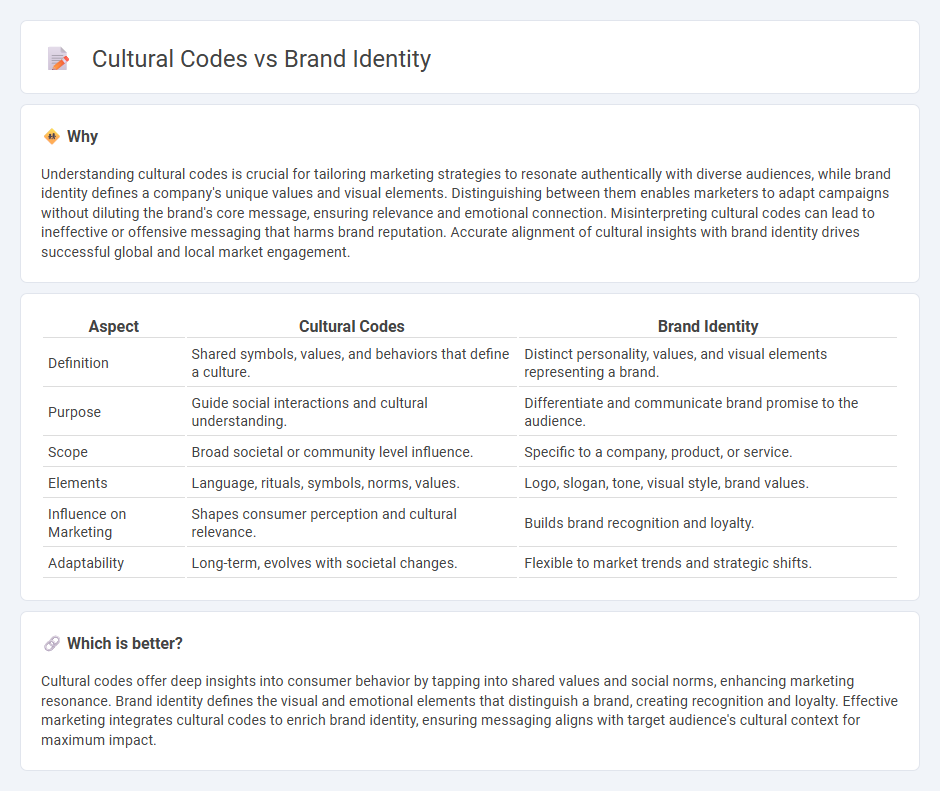
Cultural codes shape the underlying symbols, values, and behaviors that influence consumer perceptions and drive marketing strategies, while brand identity represents the unique visual and emotional characteristics that distinguish a company in the marketplace. Aligning cultural codes with brand identity enhances authenticity and fosters deeper connections with target audiences, improving brand loyalty and market relevance. Explore how integrating cultural insights can elevate your brand identity to resonate more powerfully with diverse consumer segments.
Why it is important
Understanding cultural codes is crucial for tailoring marketing strategies to resonate authentically with diverse audiences, while brand identity defines a company's unique values and visual elements. Distinguishing between them enables marketers to adapt campaigns without diluting the brand's core message, ensuring relevance and emotional connection. Misinterpreting cultural codes can lead to ineffective or offensive messaging that harms brand reputation. Accurate alignment of cultural insights with brand identity drives successful global and local market engagement.
Comparison Table
| Aspect | Cultural Codes | Brand Identity |
|---|---|---|
| Definition | Shared symbols, values, and behaviors that define a culture. | Distinct personality, values, and visual elements representing a brand. |
| Purpose | Guide social interactions and cultural understanding. | Differentiate and communicate brand promise to the audience. |
| Scope | Broad societal or community level influence. | Specific to a company, product, or service. |
| Elements | Language, rituals, symbols, norms, values. | Logo, slogan, tone, visual style, brand values. |
| Influence on Marketing | Shapes consumer perception and cultural relevance. | Builds brand recognition and loyalty. |
| Adaptability | Long-term, evolves with societal changes. | Flexible to market trends and strategic shifts. |
Which is better?
Cultural codes offer deep insights into consumer behavior by tapping into shared values and social norms, enhancing marketing resonance. Brand identity defines the visual and emotional elements that distinguish a brand, creating recognition and loyalty. Effective marketing integrates cultural codes to enrich brand identity, ensuring messaging aligns with target audience's cultural context for maximum impact.
Connection
Cultural codes shape consumers' values, beliefs, and behaviors, which brands must understand to create authentic and resonant brand identities. Effective marketing integrates cultural symbols, language, and rituals to align brand identity with target audience cultural frameworks, enhancing emotional engagement and loyalty. Brands that successfully decode and embed relevant cultural meanings gain competitive advantage and foster deeper market connections.
Key Terms
Source and External Links
What Is Brand Identity? | The Branding Journal - Brand identity is the unique personality, appearance, and characteristics of a brand that differentiate it from competitors and help build emotional connections and consistency with consumers, ultimately supporting long-term success.
What is brand identity? (and how to build one) - Canva - Brand identity is the combination of visual elements like color palette, logo, fonts, and voice that represents a company's personality and values, serving as the face of the brand to create recognition and connection with the target audience.
What is Brand Identity? | Professional Academy - Brand identity consists of the tools and elements a company uses to communicate its mission, values, market position, and goals, influencing how customers perceive the brand and form associations with it.
 dowidth.com
dowidth.com